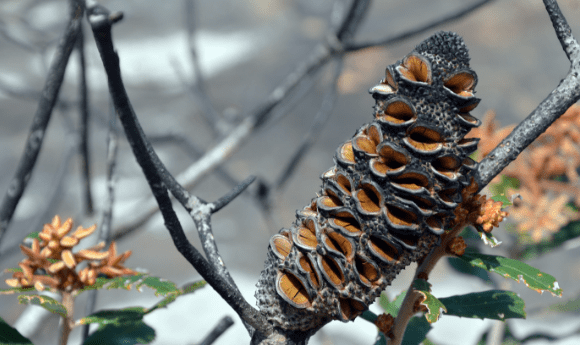
The catastrophic 2019 and 2020 bushfires that swept across approximately 10,300,000 ha of Australia impacted millions of mammals, reptiles and birds. Scientists, working in conjunction with the Threatened Species Commissioner, immediately began planning how to prioritise the use of Australian Government funding to assist in the recovery of animal populations.
However, fire-affected animal populations rely on vegetation communities that sustain them. Animals need plants to survive: they provide the food and habitat needed for them to grow, reproduce and survive.
“It became clear that while some plant species recover well from fire, there are a lot of plant species that may struggle to recover, especially when fire is combined with other threats,” said Dr Rachael Gallagher, Associate Professor of plant conservation and ecology at Western Sydney University.

Plant Traits Guide Conservation and Recovery Action
To understand the impact of these unprecedented fires on plant species, Dr Gallagher and her colleagues raced to discover what influenced their recovery potential following fire. To do that, they needed to understand the characteristics of plant species, their ‘traits’, which capture information about their response to disturbance.
Plant trait information held within Austraits¹–a new national database of Australian plant traits that synthesises data on 448 traits across 28,640 plant species–guided the prioritisation of recovery actions and conservation planning on a national scale². AusTraits was developed with co-investment from the ARDC and in partnership with 19 institutions.
Using AusTraits, Dr Gallagher and her colleagues could answer vital questions that shaped how plant species were prioritised for recovery actions. “We asked: How does a plant respond after it has been burnt? Can it re-sprout? Or were the adults killed by fire and the species only germinates from the seed bank? Which species require prioritisation over others?” said Dr Gallagher.
“Synthesised national information about plant response to fire was vital. If we hadn’t had AusTraits, it would have been doubly difficult to be able to do the work for the Threatened Species Commissioner.”
With the help of AusTraits, Dr Gallagher and colleagues were able to combine data on geographic ranges, fire extent, response traits and fire history to assess the proportion of plant species ranges burnt in the past as well as in the 2019–2020 fires². They used this information to create a strategic approach to prioritising plant species affected by fire for recovery actions and conservation planning at a national scale.
The research has led to new plant species and ecosystems being assessed and listed as threatened under the Environment Protection and Biodiversity Conservation Act 1999 (EPBC Act) via the Threatened Species Scientific Committee and the Australian Government Department of Climate Change, Energy, the Environment and Water (DCCEEW). This will help to ensure iconic animals, like the koala and wombat, have the habitat they need to recover, reproduce and thrive.
Lots of Data, But No Way to Use It
The journey to creating AusTraits began when Dr Daniel Falster, ARC Future Fellow at UNSW Sydney, and Dr Gallagher, alongside their colleagues recognised the vital need for this information to be made available to scientists.
“Over the last 20 years, there’s been a big shift in our understanding of plants globally, which is focused on functional characteristics. These are what we call traits,” said Dr Falster.
Traits are relevant in multiple scientific fields: taxonomy and systematics, ecology, and conservation, where they provide useful metrics for summarising how species grow, their morphology, and what types of species are being impacted by climate change.
Observations of plant traits come from collections in herbariums and from ecologists describing plants in the field. An example of a plant trait observation could be “a robust shrub or tree to 8 m tall, fire-tolerant” and “herb with tuber; vertical stolon 5-10 cm long.”
“The first problem was that there’s all this trait information out there, but it wasn’t readily available for scientists to use. So we wanted to compile all the available information about traits and make that readily available for Australian scientists,” said Dr Falster.
“The second problem was that trait data comes from different places, and often they’ll use varying terms, units and descriptions for essentially the same things.”
Austraits was created to incorporate data from hundreds of sources and harmonise that data. It has a workflow and rigorous review process that has enabled it to capture data from over 400 different sources, which includes decades of data collected by ecologists and plant collections in herbariums from across Australia.
The AusTraits team worked with the original data collectors for over 350 published scientific articles to harmonise traits data and bring it into AusTraits via a robust workflow and rigorous review process.
The database is clearly solving data challenges for ecologists. Since its launch in 2021, 30 scientific papers have cited it and many more projects using the data are in train.
Understanding response to fire is only one of the many applications for AusTraits. The database is now being used in diverse projects, including broadscale patterns of flowering, changes in traits with the environment, patterns of richness across the landscape, and devising next generation models for simulating vegetation dynamics.

Creating the International Gold-Standard Traits Database
The ARDC’s co-investment model has enabled the AusTraits team to create an international gold-standard traits database.
The first step in the journey to create AusTraits was holding a series of workshops, where researchers with diverse expertise came together to discuss the scope of each plant trait and its allowable values. These workshops were co-led by Dr Elizabeth Wenk, the AusTraits Project Manager, and Dr Hervé Sauquet, a Senior Research Scientist at the Royal Botanic Gardens and Domain Trust. Dr Sauquet joined the AusTraits team soon after its inception, adding the perspective and needs of the plant systematics community. The workshops benefited from the breadth of knowledge of the participants, establishing clearly defined traits that will be used by researchers across the plant sciences.
Following the workshops, Dr Wenk began working with experts from the ARDC Research Vocabularies Australia to establish plant trait definitions. AusTraits will be the first traits database in the world where definitions for traits are linked across databases internationally.
“We’ve had fantastic feedback from groups working in Europe on really big trait databases. These groups are already looking towards AusTraits for definitions that are transparent, defined, publishable and connected, which are initiatives they have not yet undertaken,” said Dr Wenk.
Dr Falster added, “The co-investment from the ARDC has helped make the international definitions of traits possible in two ways. One, it forces us to pay attention to vocabularies, without which we probably would have overlooked them as most ecologists would. Two, the ARDC provided the skills to navigate the very complex landscape of formal vocabularies and definitions.
“We are excited that there will be a published vocabulary, but also that that vocabulary will be relevant for our international colleagues as well, helping them navigate that landscape.”
Dr Falster shared that AusTraits has garnered international attention.
“We recently presented Austraits at an international Open Traits Network meeting, and several people reached out to say that this is clearly the gold standard now on how to make a reproducible trait database.”
The team is now working to expand the trait database to all kinds of organisms, not just plants. In fact, the database can be applied to all types of big data resources.
“Lots of big datasets are created from merging lots of small data pieces,” said Dr Falster.
“Small data arrives publication by publication, and that’s really the case for most biodiversity research, where no one is funding anyone to go out and measure all the traits of all the organisms in Australia. It happens research project by research project. This means that the small data arrives in thousands of fragments, which then need to be put together.”
The team has therefore built AusTraits as a generic work pipeline for harmonising datasets.
“We envisage AusTraits as a tool for anyone who wants to build a database by putting lots of fragments of data together.”
ARDC Co-Investment Vital for AusTraits
According to Dr Falster, before the ARDC came into existence, “There was no real avenue for funding anything like this that we could see. We built what we could on fragments of funding from other research projects.”
The team received co-investment through the ARDC Discovery program and then the ARDC National Data Assets program, which has helped the team identify and address a number of issues with AusTraits to ensure it is FAIR.
“The new project has enabled us to really invest in that in a big way and improve the quality of the data that is in there, as well as greatly expand the quality of the amount of data available,” said Dr Falster.
The AusTraits team is now working with 3 different platforms to incorporate AusTraits data:
- The Atlas of Living Australia, a fellow NCRIS facility like the ARDC, will have a tab on its species information pages displaying traits of species
- The ARDC co-investment platform EcoCommons will have AusTraits data available to use for modelling experiments
- Flora of Australia will incorporate AusTraits data in its synthesis of taxonomic knowledge of the country’s flora.
Would you like to contribute data to AusTraits? Contact the team.
Learn more about AusTraits, and visit the AusTraits and ARDC booths at the upcoming ESA-SCBO conference.
¹Falster DS, Gallagher RV, et al. (2021) AusTraits, a curated plant trait database for the Australian flora. Scientific Data 8, 254. https://doi.org/10.1038/s41597-021-01006-6
²Gallagher, RV, Allen, S, Mackenzie, BDE, et al. High fire frequency and the impact of the 2019–2020 megafires on Australian plant diversity. Divers Distrib. 2021; 27: 1166– 1179. https://doi.org/10.1111/ddi.13265
AusTraits received co-investment (https://doi.org/10.47486/DP720) from the ARDC. The ARDC is funded by the National Collaborative Research Infrastructure Strategy (NCRIS).
AusTraits is a partnership between UNSW, Macquarie University, Royal Botanic Gardens and Domain Trust, Centre for Australian National Biodiversity Research, The University of Melbourne, Western Sydney University, EcoCommons, CSIRO, Landcare Research New Zealand, University of New England, Murdoch University, University of Arizona, Department of Agriculture, Water and the Environment: Australian Biological Resources Study, Parks Australia, Atlas of Living Australia, Arthur Rylah Institute for Environmental Research, NSW Department of Planning, Industry and Environment, Western Australia Department of Biodiversity, Conservation and Attractions, and Greening Australia.
Author
Reviewed by
Categories
Research Topic
Related Program
Related Projects
Related News & Events
Related Case Studies







